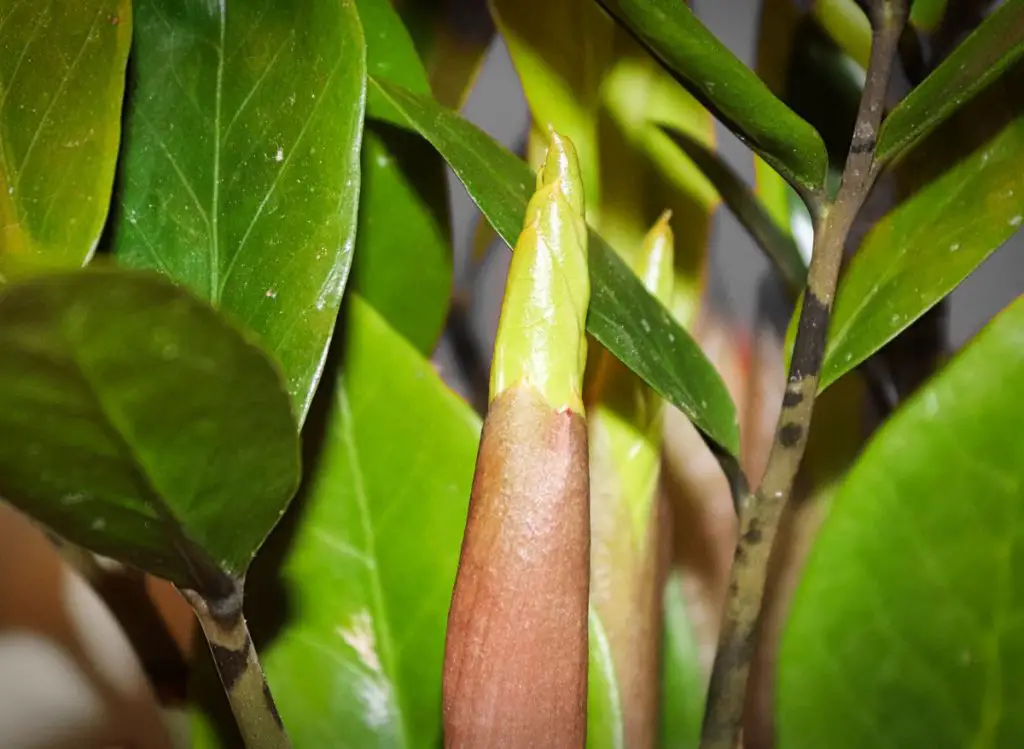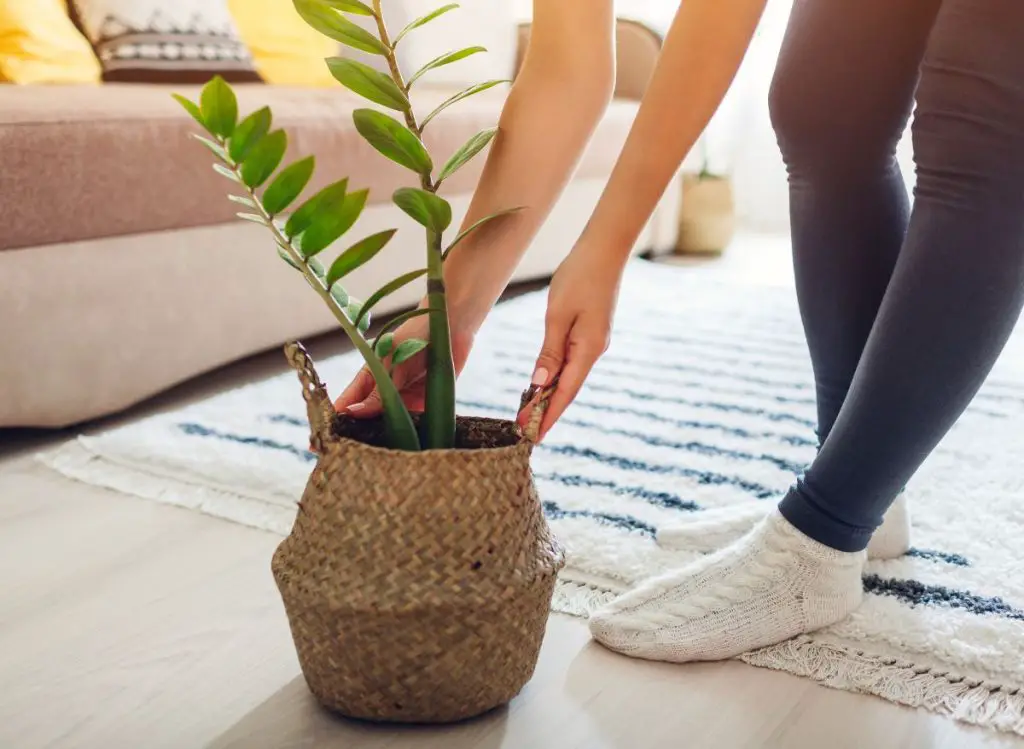
Have you ever heard of the ZZ plant? If you are considering a beautiful house plant that requires minimal care, the ZZ plant is worth looking into.
However, if this plant is not well-cared for, its luxuriant leaves and the source of their beauty can turn brown, yellow, dull, or curl.
Like any other house plant with green leaves, the yellowing of the foliage signifies the plant’s cry for help. ZZ plant leaves may turn yellow because of root rot from overwatering, underwatering, light and fertilizing issues, and extreme temperature.
The plant may not survive if immediate action is not taken to mitigate the underlying problem.
This article addresses the issue of ZZ leaves turning yellow, its causes, and how to fix it. So, if you have a ZZ plant in your house with this issue, read on to find practical solutions and preventive measures.
You might also enjoy reading: Why Is Your ZZ Plant Leaves Turning Brown? (6 Reasons and tips to fix them)
ZZ Plant Growth Characteristics
ZZ plants are slow-growing plants that thrive in bright, indirect sunlight. One of the advantages of the ZZ plant is that it requires low maintenance and can do well in many lighting conditions.
If you want to plant or repot a ZZ plant, I suggest you do it during its active growth phase in the spring or summer.
The table below shows an overview of ZZ plant growth
| Scientific Name | Zamioculcas zamiifolia |
| Common Names | – Zanzibar Gem – Zuzu Plant – Aroid Palm – Aroid Plant – Eternity Plant – Emerald Palm |
| Family | Araceae |
| Life Cycle | Perennial |
| Plant Type | – Succulent – Houseplant – Poisonous – Perennial |
| Dimensions | ZZ Plant can grow between 2 to 4 ft. tall and 2 to 4 ft wide. |
| Light Requirements | – ZZ plant thrives in deep shade with less than 2 hours to no direct sunlight. – It also does well in partial shade with direct sunlight, about 2 to 6 hours of sun exposure. |
| Soil Requirements | ZZ plant thrives in well-draining, high organic, and sandy soil. |
| ZZ Plant Maintenance Requirements | It requires low maintenance |
| ZZ Plant Soil pH requirements | Between 6 and 7 |
| ZZ Plant Bloom Time | ZZ plants generally flower, and the time for flowering is typically mid-summer to early autumn. |
| Flower Color | – Green – Yellow – White – Cream/Tan |
| Recommended Propagation Method | – Leaf Cutting – Division |
| Toxicity | ZZ plant is considered poisonous to humans and pets if ingested (Source: Iowa State University) |
| USDA Plant Hardiness Zone | 9 to 10 |
| Region Of Origin | Africa |
Why My ZZ Plant Leaves Are Turning Yellow?
If you see ZZ plant leaves turn yellow, it is a sign of stress. However, sometimes the leaves may turn yellow because they are old. The plant often sheds off old leaves at the bottom because they are not beneficial.
Other factors that cause leaf discoloration include:
1- Excess Direct Sunlight
Like most house plants, the ZZ plant thrives in low-to-moderate light. And it is their moderate light requirement that makes them a good choice for house plants in dark spaces.
Overexposure to the scorching sunlight will distress the plant, causing the yellowing and burning of leaves. But how do you know the yellowing of the ZZ leaves is caused by excess direct sunlight?
You will likely see sunburn spots on the beautiful leaves since the sun burns or damages the cells of the leaves.
How To Correct Overexposure To Sun Rays?
Although you may not reverse the spots, you can prevent the situation from worsening. How?
- For starters, move the plant to a place in the room with low lighting.
- If the plant is near a window with direct sunlight, especially the east or west-facing window, cover it with sheer curtains or blinds to filter rays hitting the ZZ plant leaves.
- Alternatively, you can move the plant to a shade-like structure, such as a patio, for an outdoor ZZ.
2- Overfertilization
Are you the person who thinks plants need excess manure to look healthy and dark green? True, fertilizer is essential for plant health, especially the leaves; however, excess fertilizer does the exact opposite.
Fertilizer is salty; when applied in excess, the plant will not absorb all of it, meaning it will remain in the soil as salt deposits. When it accumulates around the plant’s root, it interferes with the ZZ plant’s ability to absorb water ad nutrients.
Ironically, the salt concentration in the soil draws moisture and water from the plant roots. So, instead of the plant absorbing water, it is losing. Weak roots will not also absorb nutrients effectively, thus leading to the yellowing of leaves.
How do I know I am overfertilizing the ZZ plant? You will likely see salt deposits on the pot rims and soil surface.
How To Fix The Overfertilization Problem?
- Create a fertilization schedule where you apply fertilizer once a month during the plant’s growth period between April and August. During winter, the plant does not need fertilizer because they are dormant.
- You can remove the excess fertilizers by flushing them out with water. Ensure the container has enough drainage, then run water through it to remove all extra salt. Once that is done, avoid overfertilizing in your subsequent applications.
- Applying fertilizer during winter when the plant is not growing will lead to root and stem burns, causing leaf discoloration.
- On the other hand, under fertilization or failure to fertilize your ZZ plant means poor soil nutrients that can also cause yellow foliage.
If you are still wondering How Often To Fertilize ZZ Plant, I wrote a whole article that I encourage you to read.
3- Overwatering
All plants need adequate water to absorb nutrients and grow healthy and strong. However, excess moisture can damage the plant. In fact, overwatering is the number one culprit for ZZ plant leaves turning yellow.
Since ZZ plants are drought-resistant plants, overwatering distresses them. They are unlike other house plants that need daily or weekly watering because they have rhizomes for storing water.
Once they absorb the water, they can remain hydrated for two weeks during summer and three weeks during winter.
If you consistently overwater your ZZ plants, their roots will rot because water flushes out oxygen, thus promoting fungal growth. Rotten roots will not utilize nourishment effectively, leading to leaf yellowing.
How Do I Know The ZZ Plant Is Overwatered?
- Check the topsoil for dampness.
- The rhizomes have rot issues like a foul odor.
- The water is stagnant.
How To Fix The Problem Of Overwatering?
- The first step is to eliminate the excess water by creating more drainage holes on the bottom and sides of the potting container.
- If part of the roots is rotten, you could chop it off and leave only the healthy part to remove any possible fungal growth.
- Ensure the potting mix container has enough drainage holes before planting your ZZ plant or watering.
- Consider seasons and weather conditions when deciding on watering frequency. You may water after every two weeks in the summer and once a month in the winter.
- Before watering, check the soil’s moisture content. And if a few inches from the top of the soil is still wet, do not water.
4- Underwatering
Although the ZZ plants are drought-resistant, underwatering due to severe neglect can cause the leaves to wither, droop, and turn yellow. You will notice the leaves curling; if immediate action is not taken, the plant will eventually die.
Underwatering also means the plant is losing more than it is absorbing. And with less water, the plant will not effectively utilize nutrients, resulting in stunted growth and dull leaves.
How To Fix The Underwatering Problem?
- Have a consistent watering schedule and follow it.
- Regularly check if a few inches from the topsoil feel dry using your fingers and water.
- You can water from the top using a watering can or submerge the pot in a sink or bathtub until your see water bubbles on top of the soil.
Note: Watering frequency depends on the season, weather conditions, and plant and pot size.
5- Pest Infestation
Spider mites and mealybugs can also attack your ZZ plant leaves and suck on the sap, thus draining its moisture. If you leave the pests to multiply on your plant, they will weaken the plant and turn its leaves yellow.
The situation can worsen if the plant is already stressed from overwatering and nutrient deficiency.
How To Fix Pest Infestation?
- First, you want to check if pests are present by examining the ZZ plant leaves, mainly the underside, to see if they are hiding there.
- You may also see holes from pests’ bites, showing they have been enjoying the ZZ plant’s sap.
- If you identify a growing number of spider mites or any other pets, administer pest control measures to redeem your plant from these veracious organisms.
- One way to control pests is regularly spraying neem oil on the leaves until all the problems are gone. If you cannot find neem oil, you can buy the appropriate pesticide from your local store and follow the packaging procedure when applying it to kill pests.
- You could also isolate the infested plant for treatment before mixing it with others. Chop off the damaged leaves and treat the healthy ones.

Can I Turn The Yellow ZZ Leaves Green Again?
Undoubtedly, we all love it when our ZZ plant has green leaves since it creates a beautiful appearance on our home’s interior décor. However, prolonged neglect often leads to the yellowing of leaves, and it may be challenging to change them green again.
You can take corrective measures to prevent fresh leaves from turning yellow and keep your plant healthy. Yellow leaves lack chlorophyll and may not absorb adequate light for photosynthesis, significantly if the entire leaf has changed color.
Nevertheless, if some parts of the leave are still green, changing the growing condition can improve their health and make them useful for energy production.
Can I Trim The Yellow Leaves?
You can trim the yellow leaves to make your plant more presentable and healthier. You can also take this action if pests have invaded the leaves to curb further spreading. Some also remove damaged or dead old leaves to make the plant symmetrical.
If you want to trim your ZZ plant, you may find the following tips helpful:
- Do your trimming early in the spring when the growth period is about to begin
- Ensure your pruning shears or scissors are sterilized
- When pruning old or diseased leaves, ensure you cut them from where they meet the stem.
Final Words
ZZ plants are easy to grow and low-maintenance house plants; however, if you neglect them, they will show it in yellowing leaves. So, avoid overwatering and underwatering for better leaves.
You also want to give adequate manure during their growth period, look for pest infestation, and take corrective measures.

